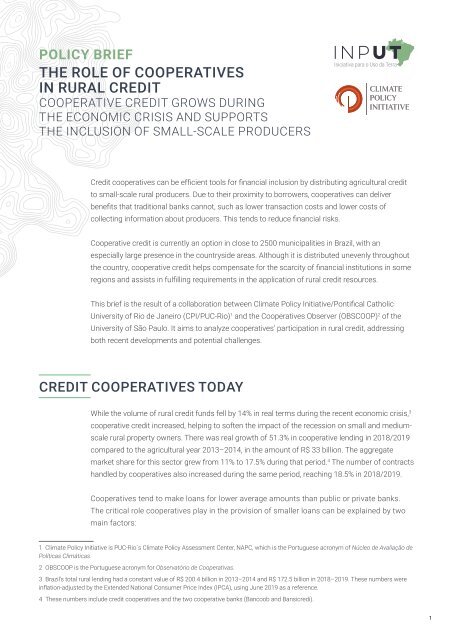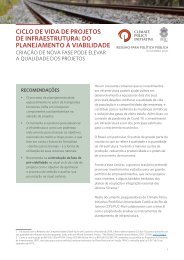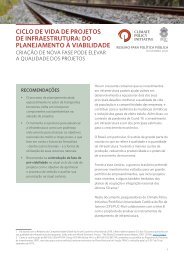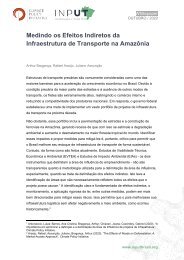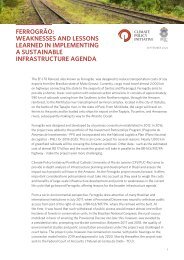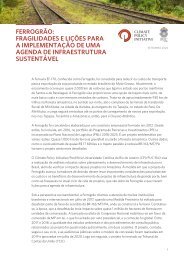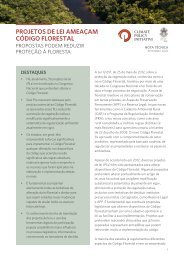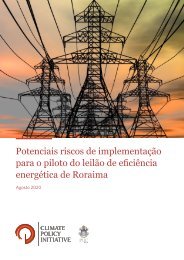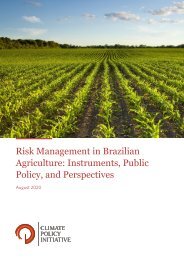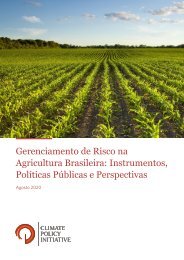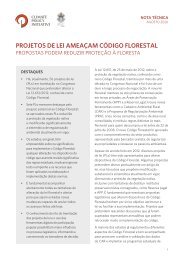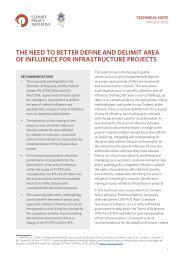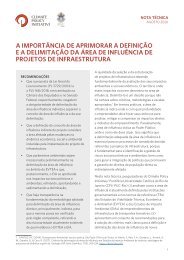The Role of Cooperatives in Rural Credit
You also want an ePaper? Increase the reach of your titles
YUMPU automatically turns print PDFs into web optimized ePapers that Google loves.
POLICY BRIEF<br />
THE ROLE OF COOPERATIVES<br />
IN RURAL CREDIT<br />
COOPERATIVE CREDIT GROWS DURING<br />
THE ECONOMIC CRISIS AND SUPPORTS<br />
THE INCLUSION OF SMALL-SCALE PRODUCERS<br />
<strong>Credit</strong> cooperatives can be efficient tools for f<strong>in</strong>ancial <strong>in</strong>clusion by distribut<strong>in</strong>g agricultural credit<br />
to small-scale rural producers. Due to their proximity to borrowers, cooperatives can deliver<br />
benefits that traditional banks cannot, such as lower transaction costs and lower costs <strong>of</strong><br />
collect<strong>in</strong>g <strong>in</strong>formation about producers. This tends to reduce f<strong>in</strong>ancial risks.<br />
Cooperative credit is currently an option <strong>in</strong> close to 2500 municipalities <strong>in</strong> Brazil, with an<br />
especially large presence <strong>in</strong> the countryside areas. Although it is distributed unevenly throughout<br />
the country, cooperative credit helps compensate for the scarcity <strong>of</strong> f<strong>in</strong>ancial <strong>in</strong>stitutions <strong>in</strong> some<br />
regions and assists <strong>in</strong> fulfill<strong>in</strong>g requirements <strong>in</strong> the application <strong>of</strong> rural credit resources.<br />
This brief is the result <strong>of</strong> a collaboration between Climate Policy Initiative/Pontifical Catholic<br />
University <strong>of</strong> Rio de Janeiro (CPI/PUC-Rio) 1 and the <strong>Cooperatives</strong> Observer (OBSCOOP) 2 <strong>of</strong> the<br />
University <strong>of</strong> São Paulo. It aims to analyze cooperatives’ participation <strong>in</strong> rural credit, address<strong>in</strong>g<br />
both recent developments and potential challenges.<br />
CREDIT COOPERATIVES TODAY<br />
While the volume <strong>of</strong> rural credit funds fell by 14% <strong>in</strong> real terms dur<strong>in</strong>g the recent economic crisis, 3<br />
cooperative credit <strong>in</strong>creased, help<strong>in</strong>g to s<strong>of</strong>ten the impact <strong>of</strong> the recession on small and mediumscale<br />
rural property owners. <strong>The</strong>re was real growth <strong>of</strong> 51.3% <strong>in</strong> cooperative lend<strong>in</strong>g <strong>in</strong> 2018/2019<br />
compared to the agricultural year 2013–2014, <strong>in</strong> the amount <strong>of</strong> R$ 33 billion. <strong>The</strong> aggregate<br />
market share for this sector grew from 11% to 17.5% dur<strong>in</strong>g that period. 4 <strong>The</strong> number <strong>of</strong> contracts<br />
handled by cooperatives also <strong>in</strong>creased dur<strong>in</strong>g the same period, reach<strong>in</strong>g 18.5% <strong>in</strong> 2018/2019.<br />
<strong>Cooperatives</strong> tend to make loans for lower average amounts than public or private banks.<br />
<strong>The</strong> critical role cooperatives play <strong>in</strong> the provision <strong>of</strong> smaller loans can be expla<strong>in</strong>ed by two<br />
ma<strong>in</strong> factors:<br />
1 Climate Policy Initiative is PUC-Rio´s Climate Policy Assessment Center, NAPC, which is the Portuguese acronym <strong>of</strong> Núcleo de Avaliação de<br />
Políticas Climáticas.<br />
2 OBSCOOP is the Portuguese acronym for Observatório de Cooperativas.<br />
3 Brazil’s total rural lend<strong>in</strong>g had a constant value <strong>of</strong> R$ 200.4 billion <strong>in</strong> 2013–2014 and R$ 172.5 billion <strong>in</strong> 2018–2019. <strong>The</strong>se numbers were<br />
<strong>in</strong>flation-adjusted by the Extended National Consumer Price Index (IPCA), us<strong>in</strong>g June 2019 as a reference.<br />
4 <strong>The</strong>se numbers <strong>in</strong>clude credit cooperatives and the two cooperative banks (Bancoob and Bansicredi).<br />
1
1) <strong>Cooperatives</strong> help banks meet requirements for the application <strong>of</strong> rural<br />
credit resources<br />
Commercial banks are required to direct a percentage <strong>of</strong> demand deposits and rural sav<strong>in</strong>gs to<br />
rural credit at controlled rates determ<strong>in</strong>ed by the Agricultural Plan (PAP) 5 and the National Plan for<br />
Strengthen<strong>in</strong>g Family Farm<strong>in</strong>g (Pronaf). 6 Commercial banks — particularly private banks — use<br />
credit cooperatives to distribute the rural credit required by current regulations. Thus, commercial<br />
banks ma<strong>in</strong>ta<strong>in</strong> a portion <strong>of</strong> their requisite funds for their clients and transfer to cooperatives the<br />
rema<strong>in</strong><strong>in</strong>g funds along with the task <strong>of</strong> their application.<br />
2) <strong>Cooperatives</strong>’ proximity to producers makes them an important distribution<br />
channel for rural credit<br />
With better access to producers, cooperatives can reduce the costs <strong>of</strong> transactions and decrease<br />
<strong>in</strong>formation asymmetry (when the f<strong>in</strong>ancial <strong>in</strong>stitution is not completely familiar with the type <strong>of</strong><br />
producer or is not able to fully monitor their actions, <strong>in</strong>creas<strong>in</strong>g the risk <strong>of</strong> loan default). Lend<strong>in</strong>g<br />
can be simplified when a rural producer is also a member <strong>of</strong> a cooperative, s<strong>in</strong>ce to become<br />
a member the credit borrower must present a file <strong>of</strong> personal and property documents. <strong>The</strong><br />
analysis <strong>of</strong> these documents can provide helpful <strong>in</strong>formation for evaluat<strong>in</strong>g the credit transaction<br />
and reduce <strong>in</strong>formation asymmetry. Moreover, be<strong>in</strong>g a cooperative member with an <strong>in</strong>terest <strong>in</strong> the<br />
cooperative’s results can encourage producers to avoid moral hazard behavior.<br />
<strong>The</strong>se organizations also have other monitor<strong>in</strong>g mechanisms. For example, neighbors <strong>of</strong><br />
a producer who has taken out credit <strong>of</strong>ten jo<strong>in</strong> the same cooperative, which can help with<br />
verification <strong>in</strong> cases <strong>of</strong> loss <strong>of</strong> production or loan default. This also contributes to a reduction <strong>in</strong><br />
problems with <strong>in</strong>formation asymmetry and the costs <strong>of</strong> transactions.<br />
Chart 1 details the structure <strong>of</strong> the National System <strong>of</strong> Cooperative <strong>Credit</strong> (SNCC). 7 For the<br />
2018/19 agricultural year, 393 <strong>in</strong>dividual cooperatives conducted rural f<strong>in</strong>anc<strong>in</strong>g transactions<br />
(Central Bank <strong>of</strong> Brazil). 8<br />
5 PAP is the Portuguese acronym for Plano Agrícola e Pecuário.<br />
6 Pronaf is the Portuguese acronym for Programa Nacional de Fortalecimento da Agricultura Familiar. It is currently developed by the M<strong>in</strong>istry<br />
<strong>of</strong> Agriculture, Livestock and Food Supply (M<strong>in</strong>istério da Agricultura, Pecuária e Abastecimento). Between 2016 and 2018, Pronaf was run by<br />
the Special Bureau <strong>of</strong> Family Agricultural and Agrarian Development (Secretaria Especial de Agricultura Familiar e do Desenvolvimento Agrário),<br />
associated with the Civil House <strong>of</strong> the Presidency <strong>of</strong> the Republic. Before 2016, Pronaf was run by the M<strong>in</strong>istry <strong>of</strong> Agrarian Development<br />
(M<strong>in</strong>istério do Desenvolvimento Agrário). Of the total rural credit funds <strong>in</strong> 2017/18 agricultural year, 31.8% came from compulsory resources<br />
under the rules <strong>of</strong> the <strong>Rural</strong> <strong>Credit</strong> Manual (Manual do Crédito <strong>Rural</strong>, MCR), Chapter 6.2; and 24.4% came from rural sav<strong>in</strong>gs (under the rules <strong>of</strong><br />
MCR 6.4).<br />
7 SNCC is the Portuguese acronym for Sistema Nacional de Crédito Cooperativo. In 2018 the SNCC <strong>in</strong>cluded 940 <strong>in</strong>dividual cooperatives,<br />
34 central cooperatives, 2 confederations, and 2 cooperative banks (data from the Central Bank <strong>of</strong> Brazil). <strong>The</strong> SNCC held R$ 475.2 billion <strong>in</strong><br />
assets <strong>in</strong> December <strong>of</strong> 2017, represent<strong>in</strong>g nearly 4% <strong>of</strong> the National F<strong>in</strong>ancial System (Sistema F<strong>in</strong>anceiro Nacional).<br />
8 Data from the <strong>Rural</strong> <strong>Credit</strong> Data Matrix from the Central Bank <strong>of</strong> Brazil.<br />
2
Chart 1: <strong>Cooperatives</strong> and Cooperative Banks<br />
INDIVIDUAL COOPERATIVES<br />
First-grade cooperatives<br />
At least 20 members<br />
<strong>The</strong>se economic organizations are collectively owned<br />
and belong to a group <strong>of</strong> members, mostly <strong>in</strong>dividuals,<br />
who use their products and services.<br />
Each member has a vote <strong>in</strong> these organizations,<br />
regardless <strong>of</strong> the amount <strong>of</strong> social capital they<br />
contribute<br />
CENTRAL COOPERATIVES<br />
Second-grade cooperatives<br />
At least 3 <strong>in</strong>dividual cooperatives<br />
<strong>The</strong>se organizations’ property belongs exclusively to<br />
a group <strong>of</strong> <strong>in</strong>dividual cooperatives. This arrangement<br />
generates economy <strong>of</strong> scale for members, allow<strong>in</strong>g<br />
them to develop products and services at lower costs<br />
than they would be able to separately.<br />
A central cooperative has an average <strong>of</strong> 23<br />
associated <strong>in</strong>dividual cooperatives. Central<br />
cooperatives’ control systems take <strong>in</strong>to account the<br />
different levels <strong>of</strong> capital contributions each <strong>in</strong>dividual<br />
cooperative makes to the central cooperative.<br />
CONFEDERATIONS<br />
Third-grade cooperatives<br />
<strong>The</strong>se are contractual arrangements created<br />
by central cooperatives. <strong>The</strong>ir function is to<br />
coord<strong>in</strong>ate, set norms, supervise, sponsor, and give<br />
technological support for the f<strong>in</strong>ancial processes<br />
and services provided by central cooperatives<br />
to <strong>in</strong>dividual cooperatives, and by <strong>in</strong>dividual<br />
cooperatives to their members.<br />
In 2018 two cooperative confederations were<br />
registered with the Central Bank <strong>of</strong> Brazil: <strong>The</strong><br />
Confederation <strong>of</strong> <strong>Cooperatives</strong> <strong>of</strong> the SICREDI<br />
System (Confederação das Cooperativas do Sistema<br />
SICREDI), and the Confederation <strong>of</strong> <strong>Cooperatives</strong> <strong>of</strong><br />
the SICOOB System (Confederação das Cooperativas<br />
do Sistema SICOOB).<br />
COOPERATIVE BANKS<br />
<strong>The</strong>se are commercial or multiple banks with<br />
commercial portfolios; their shareholder control<br />
belongs to the central credit cooperatives. <strong>The</strong>ir<br />
work <strong>in</strong>volves develop<strong>in</strong>g products and services<br />
for the central and <strong>in</strong>dividual cooperatives, thereby<br />
expand<strong>in</strong>g these organizations’ f<strong>in</strong>ancial portfolios.<br />
In 2018, there were two cooperative banks: Bancoob<br />
and Banicredi.<br />
Source: Produced by the authors with data from the Central Bank <strong>of</strong> Brazil.<br />
3
<strong>The</strong>re is wide regional disparity <strong>in</strong> the geographical distribution <strong>of</strong> cooperatives’ branches. Figure<br />
1a shows the number <strong>of</strong> lend<strong>in</strong>g branches <strong>in</strong> each Brazilian municipality. <strong>Cooperatives</strong> have a<br />
higher representation <strong>in</strong> the municipalities <strong>of</strong> the South, Central-west, and Southeast, but even so,<br />
few municipalities have more than five branches. Many Brazilian municipalities, <strong>in</strong>clud<strong>in</strong>g the vast<br />
majority <strong>of</strong> the ones <strong>in</strong> the North and Northeast, don’t have any lend<strong>in</strong>g branches at all.<br />
Figure 1b shows the share <strong>of</strong> credit cooperatives compared to the total volume <strong>of</strong> rural f<strong>in</strong>anc<strong>in</strong>g<br />
at the state level. <strong>Cooperatives</strong> <strong>in</strong> the states <strong>of</strong> Rio Grande do Sul, Paraná, and Espírito Santo<br />
hold a relatively high share <strong>of</strong> the total credit — between 25% and 35% <strong>of</strong> credit <strong>in</strong> these states is<br />
distributed by cooperatives. In contrast, cooperative credit represents less than 5% <strong>of</strong> lend<strong>in</strong>g <strong>in</strong><br />
all Northeast states.<br />
Figure 1c shows this geographic distribution from another angle: the volume <strong>of</strong> cooperative credit<br />
<strong>in</strong> each state and the total cooperative credit <strong>in</strong> Brazil. In the first qu<strong>in</strong>tile, states <strong>in</strong> the North and<br />
Northeast handle up to R$ 693.5 thousand <strong>of</strong> cooperative credit. This contrasts with most <strong>of</strong> the<br />
states <strong>in</strong> the South, Southeast, and Central-West, which handle between R$ 572.9 million and<br />
R$ 7.7 billion.<br />
4
per municipality (2019)<br />
Figure 1: Geographical Distribution <strong>of</strong> Cooperative <strong>Credit</strong> <strong>in</strong> Brazil<br />
Figure 1a: Cooperative Service Po<strong>in</strong>ts (PACs)<br />
Figure 1a: Cooperative’s lend<strong>in</strong>g branches<br />
by per municipality (2019)<br />
Figure 1b: Volume <strong>of</strong> credit distributed by<br />
Figure 1b: Volume <strong>of</strong> credit distributed<br />
cooperatives, by 2018/2019<br />
(2018–2019)<br />
Number <strong>of</strong> PACs<br />
1<br />
2 to 5<br />
6 to 10<br />
11 to 14<br />
15 or more<br />
No PACs<br />
Number <strong>of</strong> PACs<br />
1<br />
2 to 5<br />
6 to 10<br />
11 to 14<br />
15 or more<br />
No PACs<br />
Amount <strong>of</strong> cooperative credit / Total amount<br />
Figura 1c: Importance <strong>of</strong> cooperative credit <strong>in</strong><br />
rural Less credit than (2018/2019) 5%<br />
5 to 10%<br />
10 to 15%<br />
15 to 25%<br />
25 to 35%<br />
No cooperatives<br />
Figure Figura 1c: 1c: Importance <strong>The</strong> importance <strong>of</strong> cooperative <strong>of</strong> cooperative credit <strong>in</strong><br />
credit rural credit for rural (2018/2019) credit, 2018/2019<br />
Amount <strong>of</strong> credit <strong>in</strong> reals (divided <strong>in</strong>to qu<strong>in</strong>tiles)<br />
45,6 thousand to 693,5 thousand<br />
2,4 mi a 17,7 mi<br />
19,3 mi a 307,8 mi<br />
572,9 mi a 2,3 bi<br />
2,4 bi a 7,7 bi<br />
No cooperatives<br />
Amount <strong>of</strong> credit <strong>in</strong> reals (divided <strong>in</strong>to qu<strong>in</strong>tiles)<br />
45,6 thousand to 693,5 thousand<br />
Source: 2,4 mi Produced a 17,7 mi by the authors with data from the Central Bank <strong>of</strong> Brazil.<br />
19,3 mi a 307,8 mi<br />
572,9 mi a 2,3 bi<br />
2,4 bi a 7,7 bi<br />
No cooperatives<br />
5
<strong>The</strong>re is a clear relationship between the presence <strong>of</strong> credit cooperatives and the volume <strong>of</strong><br />
agricultural production, as shown <strong>in</strong> Figure 2. Figure 2b shows the qu<strong>in</strong>tiles <strong>of</strong> the number <strong>of</strong><br />
agricultural establishments <strong>in</strong> each municipality divided by the municipal area, accord<strong>in</strong>g to data<br />
from the 2017 Agricultural Census by the Brazilian Institute <strong>of</strong> Geography and Statistics (IBGE). 9<br />
<strong>Cooperatives</strong>’ share <strong>of</strong> rural credit distribution is strongly l<strong>in</strong>ked to the number <strong>of</strong> agricultural<br />
establishments <strong>in</strong> a given area. A high number <strong>of</strong> small producers tends to be associated with<br />
a higher number <strong>of</strong> cooperatives (except for the Northeast, where cooperative credit is scarce<br />
despite the presence <strong>of</strong> many small producers). Data from the 2017 Agricultural Census also<br />
shows that 39%, 35%, and 18% <strong>of</strong> the agricultural establishments <strong>of</strong> Rio Grande do Sul, Paraná,<br />
and Espírito Santo, respectively, are l<strong>in</strong>ked to cooperatives.<br />
Figura 2: Agricultural Activity <strong>in</strong> Brazil<br />
Figure 2a: Agriculture – Gross value added by<br />
municipality area (2016)<br />
Figure 2b: Number <strong>of</strong> agricultural establishments<br />
by municipality area (2017)<br />
Agriculture Gross value added (R$ 1,000/Km²)<br />
N
COOPERATIVES DURING THE RECENT PERIOD<br />
OF ECONOMIC INSTABILITY<br />
<strong>The</strong> recent economic crisis did not spare rural f<strong>in</strong>anc<strong>in</strong>g. <strong>The</strong> volume <strong>of</strong> effectively f<strong>in</strong>anced rural<br />
credit fell 14% between 2013/2014 and 2018/2019, and the number <strong>of</strong> contracts decl<strong>in</strong>ed by 26%<br />
<strong>in</strong> that same period (see Table 1). <strong>The</strong>re was a correspond<strong>in</strong>g <strong>in</strong>crease <strong>of</strong> 17% <strong>in</strong> the value <strong>of</strong> the<br />
average rural credit contract, from R$ 78.1 thousand to R$ 91.4 thousand (<strong>in</strong> real values). 10 In this<br />
context, some beneficiaries <strong>of</strong> the rural credit policy stopped access<strong>in</strong>g resources.<br />
Table 1: Total value and number <strong>of</strong> rural credit contracts between 2013/2014 and 2018/2019.<br />
Year<br />
Cooperative <strong>Credit</strong> +<br />
Total<br />
Value<br />
(billion R$)<br />
Number <strong>of</strong><br />
Contracts<br />
(thousand)<br />
Private Commercial<br />
Bank<br />
Total<br />
Value<br />
(billion R$)<br />
Number <strong>of</strong><br />
Contracts<br />
(thousand)<br />
Public Commercial<br />
Bank<br />
Total<br />
Value<br />
(billion R$)<br />
Number <strong>of</strong><br />
Contracts<br />
(thousand)<br />
Total<br />
Value<br />
(billion R$)<br />
Total<br />
Number <strong>of</strong><br />
Contracts<br />
(thousand)<br />
2013–14 21,8 356,9 59,8 215,5 118,8 1994,1 200,4 2566,5<br />
2014–15 22,5 354,4 55,3 202,9 107,0 2028,1 184,8 2585,4<br />
2015–16 21,7 333,7 48,2 137,1 111,1 1846,4 181,0 2317,2<br />
2016–17 25,4 345,9 53,4 102,9 85,6 1392,8 164,5 1841,6<br />
2017–18 28,8 370,5 46,9 99,1 97,4 1143,2 173,1 1612,8<br />
2018–19 33,0 374,1 44,9 98,7 94,8 1413,4 172,5 1886,3<br />
+<br />
Includes credit cooperatives and cooperative banks.<br />
* Values are <strong>in</strong>flation adjusted by the Extended National Consumer Price Index (IPCA) to June 2019 levels.<br />
Source: Produced by the authors with data from the <strong>Rural</strong> <strong>Credit</strong> Data Matrix from the Central Bank <strong>of</strong> Brazil, 2019.<br />
10 Values are <strong>in</strong>flation adjusted by the Extended National Consumer Price Index (IPCA), with reference to June 2019.<br />
7
Faced with a reduction <strong>in</strong> applied volume, 11 f<strong>in</strong>ancial <strong>in</strong>stitutions possibly changed their criteria for<br />
select<strong>in</strong>g credit beneficiaries. Producers <strong>in</strong> f<strong>in</strong>ancial difficulty also changed their decisions about<br />
how much to borrow and which <strong>in</strong>stitutions to work with.<br />
While the total volume <strong>of</strong> rural credit fell, cooperative organizations <strong>in</strong>creased their rural credit<br />
lend<strong>in</strong>g from R$ 21.8 billion <strong>in</strong> 2013–2014 to R$ 33 billion <strong>in</strong> 2018–2019. This real growth <strong>of</strong><br />
51.3% means that their aggregate market share rose from 11% to 17.5%. With the expansion<br />
<strong>of</strong> credit from cooperatives – <strong>in</strong> contrast to the contraction <strong>of</strong> public and private banks – the<br />
number <strong>of</strong> beneficiaries who stopped access<strong>in</strong>g credit dur<strong>in</strong>g the economic crisis may have been<br />
lower than it might have been otherwise. Given the pr<strong>of</strong>ile <strong>of</strong> smaller producers – a group more<br />
vulnerable to restrictions on lend<strong>in</strong>g <strong>of</strong>fers – cooperatives have become particularly important.<br />
<strong>Cooperatives</strong> cushion the impact on small producers <strong>of</strong> reduced credit <strong>of</strong>fers from public and<br />
private banks.<br />
CHARACTERISTICS OF CONTRACTS<br />
IN THE VARIOUS CREDIT CHANNELS<br />
For the 2018/2019 agricultural year, there were 1.4 million rural credit contracts <strong>in</strong> public banks,<br />
374.1 thousand <strong>in</strong> cooperatives, and 98.7 thousand <strong>in</strong> private banks (see Table 1). In terms <strong>of</strong><br />
volume <strong>of</strong> credit for that agricultural year, public banks handled R$ 94.8 billion, credit cooperatives<br />
handled R$ 33 billion, and private banks handled R$ 44.9 billion. Public banks clearly dom<strong>in</strong>ate<br />
rural credit. Figure 3 shows how total credit <strong>in</strong> Brazil is divided between cooperatives, public and<br />
private banks. <strong>The</strong> dom<strong>in</strong>ant position <strong>of</strong> public banks <strong>in</strong> rural credit is evident.<br />
Figure 3: Total <strong>of</strong> rural credit lend<strong>in</strong>g by public banks, private banks and cooperatives for the 2018/2019 agricultural year<br />
Source: Produced by the authors with data from the <strong>Rural</strong> <strong>Credit</strong> Data Matrix from the Central Bank <strong>of</strong> Brazil, 2019.<br />
11 <strong>The</strong>re has been an 8% <strong>in</strong>crease <strong>in</strong> real terms <strong>in</strong> the funds announced for PAP, and 12% for Pronaf, between the crops <strong>of</strong> 2013–2014 and<br />
2017–2018. Meanwhile, <strong>in</strong> terms <strong>of</strong> effectively applied volume, there were reductions <strong>of</strong> 13% and 22% <strong>in</strong> PAP and Pronaf, respectively.<br />
8
In the same agricultural year, cooperatives and public banks had notably lower average contract<br />
values (R$ 88.2 thousand and R$ 67.1 thousand, respectively) than private banks (R$ 454.9<br />
thousand). S<strong>in</strong>ce contract values are generally related to a producer’s size, it may be <strong>in</strong>ferred that,<br />
on average, small and medium-scale producers access cooperatives and public banks, while the<br />
largest producers access private banks. Figure 4 shows the distribution <strong>of</strong> the various rural credit<br />
l<strong>in</strong>es lent by cooperatives, public banks, and private banks, and provides evidence regard<strong>in</strong>g the<br />
scale <strong>of</strong> producers access<strong>in</strong>g cooperatives’ resources. In the 2018/2019 agricultural year, 21%<br />
<strong>of</strong> funds lent by these organizations were f<strong>in</strong>anced through Pronaf and 18% through the National<br />
Program to Support Medium-sized <strong>Rural</strong> Producers (Pronamp). 12 In the same year, these numbers<br />
were 16% and 13% for public banks, and 2% and 6% for private banks. <strong>The</strong> average value <strong>of</strong> a<br />
Pronaf contract <strong>in</strong> the cooperatives was R$ 32.4 thousand, while the average value <strong>of</strong> a Pronamp<br />
contract was R$ 118.8 thousand.<br />
Figure 3: Distribution <strong>of</strong> lend<strong>in</strong>g by cooperatives, public banks, and private banks between l<strong>in</strong>es <strong>of</strong> rural credit<br />
for agricultural year 2018–2019<br />
Figure 4: Distribution <strong>of</strong> lend<strong>in</strong>g by cooperatives, public banks, and private banks by rural credit l<strong>in</strong>es for the<br />
2018/2019 agricultural year<br />
2%<br />
<strong>Cooperatives</strong><br />
54%<br />
21% 18%<br />
2%<br />
2%<br />
1.6%<br />
Public Banks<br />
66% 16% 13%<br />
0.1%<br />
3%<br />
Private Banks<br />
69%<br />
6%<br />
14% 5% 4%<br />
1.8%<br />
No Program<br />
Pronamp<br />
Funcafé<br />
Pronaf<br />
Moderfrota<br />
Others<br />
Source: Produced by the authors with data from the <strong>Rural</strong> <strong>Credit</strong> and Proagro Operations System (SICOR) from the<br />
Central Bank <strong>of</strong> Brazil.<br />
Figure 5 shows the share <strong>of</strong> various fund<strong>in</strong>g sources between agricultural years 2013/2014 and<br />
2018/2019. <strong>The</strong> most important sources <strong>of</strong> credit for cooperatives were compulsory resources <strong>of</strong><br />
check<strong>in</strong>g accounts (MCR - 6.2), 13 rural sav<strong>in</strong>gs (MCR - 6.4), 14 and Agricultural <strong>Credit</strong> Notes (LCA). 15<br />
<strong>The</strong> share <strong>of</strong> compulsory resources – which used to be the largest source <strong>of</strong> credit – dropped<br />
significantly dur<strong>in</strong>g this period: <strong>in</strong> 2013/2014, they made up 47% <strong>of</strong> the rural f<strong>in</strong>anc<strong>in</strong>g budget, but<br />
<strong>in</strong> 2018/2019 they accounted for only around 18%. On the other hand, it is <strong>in</strong>terest<strong>in</strong>g to note the<br />
growth <strong>of</strong> rural sav<strong>in</strong>gs and the LCA.<br />
12 Pronamp is the Portuguese acronym for Programa Nacional de Apoio ao Médio Produtor <strong>Rural</strong>.<br />
13 Accord<strong>in</strong>g the rules <strong>of</strong> the <strong>Rural</strong> <strong>Credit</strong> Manual (Manual do Crédito <strong>Rural</strong> - MCR 6.2), compulsory resources represent 34% <strong>of</strong> check<strong>in</strong>g<br />
account deposits made <strong>in</strong> Brazilian f<strong>in</strong>ancial <strong>in</strong>stitutions.<br />
14 <strong>The</strong> volume <strong>of</strong> deposits <strong>in</strong> rural sav<strong>in</strong>gs comes from fundrais<strong>in</strong>g associated with this f<strong>in</strong>ancial tool by federal banks (Banco da Amazônia, Banco<br />
do Nordeste, and the Banco do Brasil) and by cooperative banks. A percentage <strong>of</strong> these funds (currently 60%) must be applied to rural credit.<br />
15 LCA is the Portuguese acronym for Letras de Câmbio do Agronegócio.<br />
9
Unlike the LCA, which can be issued by credit cooperatives, funds used <strong>in</strong> transactions orig<strong>in</strong>at<strong>in</strong>g<br />
from compulsory resources derive from <strong>in</strong>terbank deposits l<strong>in</strong>ked to rural credit (DIR) 16 <strong>in</strong> public<br />
or private commercial banks, s<strong>in</strong>ce they are not subject to the same requirements. In the case <strong>of</strong><br />
resources from rural sav<strong>in</strong>gs, funds can come from Cooperative Banks, which receive deposits <strong>in</strong><br />
rural sav<strong>in</strong>gs.<br />
Figure 4: Sources <strong>of</strong> funds used by cooperatives between 2013/2014 and 2018/2019<br />
Figure 5: Fund<strong>in</strong>g sources used by cooperatives between the agricultural years 2013/2014 and 2018/2019<br />
2018/2019<br />
18%<br />
37%<br />
26%<br />
7% 6% 5%<br />
2017/2018<br />
30%<br />
27%<br />
22%<br />
7% 6% 8%<br />
2016/2017<br />
32%<br />
27%<br />
21%<br />
3% 14% 3%<br />
2015/2016<br />
31%<br />
23%<br />
32%<br />
3% 11%<br />
2014/2015<br />
40%<br />
25%<br />
21%<br />
2%<br />
11%<br />
2013/2014<br />
47%<br />
21%<br />
16%<br />
3%<br />
13%<br />
<strong>Rural</strong> <strong>Credit</strong> Fund<strong>in</strong>g Sources<br />
Compulsory Resources - MCR 6.2<br />
BNDES/ F<strong>in</strong>ame<br />
LCA<br />
<strong>Rural</strong> Sav<strong>in</strong>gs - Restricted<br />
<strong>Rural</strong> Sav<strong>in</strong>gs - Unrestricted<br />
Others<br />
Source: Produced by the authors with data from the <strong>Rural</strong> <strong>Credit</strong> and Proagro Operations System (SICOR) from the<br />
Central Bank <strong>of</strong> Brazil.<br />
<strong>The</strong> configuration <strong>of</strong> the fund<strong>in</strong>g sources f<strong>in</strong>anced by cooperatives provides evidence <strong>of</strong> the<br />
<strong>in</strong>terbank relationship between cooperatives and commercial banks. <strong>Cooperatives</strong> are becom<strong>in</strong>g<br />
an alternative channel for distribut<strong>in</strong>g required rural credit at controlled rates. That is, private<br />
banks can lend directly to select clients and allocate rema<strong>in</strong><strong>in</strong>g funds and the requirements for<br />
their adm<strong>in</strong>istration to credit cooperatives, which apply the funds.<br />
<strong>The</strong> analysis <strong>of</strong> fund<strong>in</strong>g sources used by cooperatives <strong>in</strong> rural f<strong>in</strong>anc<strong>in</strong>g shows that although<br />
the share <strong>of</strong> compulsory resources dropped <strong>in</strong> 2018/2019, this source still represents 18% <strong>of</strong><br />
their lend<strong>in</strong>g.<br />
Figure 6 shows the percentage <strong>of</strong> rural credit allocated for production costs, <strong>in</strong>vestment,<br />
commercialization, and <strong>in</strong>dustrialization <strong>in</strong> the 2018/2019 agricultural year. In all three channels<br />
<strong>of</strong> distribution, the largest share <strong>of</strong> funds went to production costs. For cooperatives, this<br />
amounted to 72% <strong>of</strong> funds, a considerably larger percentage than for public banks (59%) and<br />
private banks (43%). Like public and private banks, cooperatives lent more for <strong>in</strong>vestment (20%)<br />
than for commercialization (8%).<br />
16 DIR is the Portuguese acronym for Depósitos Interf<strong>in</strong>anceiros V<strong>in</strong>culados ao Crédito <strong>Rural</strong>.<br />
10
Between 2013/2014 and 2018/2019, while public and private banks saw reductions <strong>in</strong> the<br />
number <strong>of</strong> contracts for all purposes, cooperatives <strong>in</strong>creased their number <strong>of</strong> contracts f<strong>in</strong>anc<strong>in</strong>g<br />
production costs by 7%. For agricultural year 2018/2019, the average value <strong>of</strong> production-cost<br />
contracts held by cooperatives (R$ 79.9 thousand) was significantly lower than the average<br />
contracts <strong>of</strong> public banks (R$ 115.2 thousand) and private banks (R$ 303.8 thousand).<br />
Figure 6: Distribution <strong>of</strong> lend<strong>in</strong>g by cooperatives, public banks and private banks by rural credit types for the<br />
2018/2019 agricultural year<br />
Work<strong>in</strong>g Capital Investment Trade Industry<br />
Source: Produced by the authors with data from the <strong>Rural</strong> <strong>Credit</strong> and Proagro Operations System (SICOR) from the<br />
Central Bank <strong>of</strong> Brazil.<br />
Figure 7 shows that <strong>in</strong> agricultural year 2018/2019, cooperatives’ lend<strong>in</strong>g for production costs<br />
was predom<strong>in</strong>ately allocated to soy (33%) and beef (27%). Corn also received a significant<br />
percentage <strong>of</strong> funds for production costs (12%). While public and private banks reduced the<br />
number <strong>of</strong> contracts directed toward f<strong>in</strong>anc<strong>in</strong>g soy farm<strong>in</strong>g (production costs) by 27% and 51%<br />
respectively, cooperatives <strong>in</strong>creased this fund<strong>in</strong>g by 17% between agricultural years 2013/2014<br />
and 2018/2019. In terms <strong>of</strong> credit volume for this period, there was a decrease <strong>of</strong> 16% for private<br />
banks, an <strong>in</strong>crease <strong>of</strong> 13% for public banks, and an <strong>in</strong>crease <strong>of</strong> 112% for cooperatives.<br />
11
Figure 7: Distribution <strong>of</strong> credit cooperatives’ lend<strong>in</strong>g for work<strong>in</strong>g capital by product for the 2018/2019 agricultural year<br />
Source: Produced by the authors with data from the <strong>Rural</strong> <strong>Credit</strong> and Proagro Operations System (SICOR) from the<br />
Central Bank <strong>of</strong> Brazil.<br />
TAXATION AND REGULATION<br />
OF CREDIT COOPERATIVES<br />
<strong>Credit</strong> cooperatives benefit more from tax and regulatory advantages than banks and other<br />
f<strong>in</strong>ancial <strong>in</strong>stitutions. In terms <strong>of</strong> fiscal contributions, cooperatives are exempt from <strong>in</strong>come taxes<br />
and the Social Contribution on Net Pr<strong>of</strong>its (CSLL) 17 for cooperative actions, which are def<strong>in</strong>ed as<br />
actions aimed at meet<strong>in</strong>g social objectives, carried out between cooperatives and their members<br />
as well as among cooperatives.<br />
In the regulatory framework, some credit cooperatives are also exposed to differentiated<br />
conditions that vary accord<strong>in</strong>g to their size and operational complexity. 18 To make this<br />
dist<strong>in</strong>ction, cooperatives have been divided <strong>in</strong>to three categories by the Central Bank <strong>of</strong><br />
Brazil: full, classic, and capital and loan. Full cooperatives are authorized to carry out some<br />
operations that the others are not. <strong>The</strong> classic and capital and loan cooperatives are allowed<br />
to carry out the same activities as the full cooperatives, with the exceptions <strong>of</strong> fundrais<strong>in</strong>g and<br />
deposits between associates. 19<br />
17 CSLL is the Portuguese acronym for Contribuição Social sobre o Lucro Líquido.<br />
18 This segmentation dates to 2013, when the Central Bank decided that cooperatives should adopt one <strong>of</strong> two verification systems for<br />
the m<strong>in</strong>imum requirements for capital requests to face the f<strong>in</strong>ancial <strong>in</strong>stitution’s risks. One <strong>of</strong> the means <strong>of</strong> verification is the Full Prudential<br />
Regime (Regime Prudencial Completo, RPC), <strong>in</strong> which f<strong>in</strong>ancial <strong>in</strong>stitutions are obligated to use the calculation methodology Required<br />
M<strong>in</strong>imum Assets (Patrimonio Mínimo Requerido, PMR). <strong>The</strong> PMR takes <strong>in</strong>to account lend<strong>in</strong>g risks (associates’ failure to pay), market risks<br />
(currency and <strong>in</strong>terest rate variations), and operational risks (unexpected losses). <strong>The</strong> second option is the Basic Prudential Regime (Regime<br />
Prudencial Simples, RPS), which only covers credit risk, without calculat<strong>in</strong>g market and transactional risks, among other factors. <strong>The</strong> l<strong>in</strong>e<br />
between credit cooperatives was even more clearly drawn <strong>in</strong> 2015, when the Central Bank decided that cooperatives must follow the regime<br />
best suited to their size and level <strong>of</strong> operational complexity.<br />
19 Accord<strong>in</strong>g to Resolution no. 4.434/2015, classic cooperatives and capital and loan cooperatives are permitted the same operations with<br />
the follow<strong>in</strong>g exception: “collect<strong>in</strong>g, exclusively from associates, funds, and deposits without issuance <strong>of</strong> certificate, except for fundrais<strong>in</strong>g by<br />
municipalities, their agencies or entities and by bus<strong>in</strong>esses under their control, under the terms <strong>of</strong> article 2 <strong>of</strong> Complementary Law no. 130 <strong>of</strong><br />
2009.” This operation cannot be performed by capital and loan cooperatives.<br />
12
Changes put <strong>in</strong> place by the Central Bank <strong>in</strong> 2015 highlighted the heterogeneity between credit<br />
cooperatives. While full cooperatives are considered more complex, classic cooperatives and<br />
capital and loan cooperatives are considered more basic <strong>in</strong>stitutions, with less exposure to risk,<br />
that would benefit from governmental support. Accord<strong>in</strong>gly, full cooperatives have jo<strong>in</strong>ed the Full<br />
Prudential Regime (RPC) 20 and have adopted policies <strong>in</strong> l<strong>in</strong>e with Basel III. <strong>The</strong> other cooperatives<br />
have jo<strong>in</strong>ed the Basic Prudential Regime (RPS), 21 which facilitates their operational rout<strong>in</strong>es.<br />
Moreover, credit cooperatives are not subject to compulsory deposits, s<strong>in</strong>ce they are not required<br />
to allocate a portion <strong>of</strong> their deposits to rural credit.<br />
20 RPC is the Portuguese acronym for Regime Prudencial Completo.<br />
21 RPS is the Portuguese acronym for Regime Prudencial Simples.<br />
13
CONCLUSION<br />
<strong>Credit</strong> cooperatives have become <strong>in</strong>creas<strong>in</strong>gly important <strong>in</strong> rural credit distribution. <strong>The</strong>y are a<br />
valuable tool <strong>in</strong> agricultural policy, receiv<strong>in</strong>g tax <strong>in</strong>centives and regulatory <strong>in</strong>centives vis-à-vis<br />
the banks. <strong>The</strong>y have shown positive growth <strong>in</strong> rural lend<strong>in</strong>g dur<strong>in</strong>g the recent economic crisis,<br />
possibly s<strong>of</strong>ten<strong>in</strong>g the impact <strong>of</strong> the crisis on small producers.<br />
<strong>Cooperatives</strong>’ relationship with banks, particularly private banks, has allowed small and mediumscale<br />
producers access to credit. <strong>Cooperatives</strong>’ proximity to production areas, their ownership<br />
structures, and their operational pr<strong>of</strong>iles seem to make rural credit transactions smoother and<br />
less burdensome. <strong>The</strong>se characteristics are important <strong>in</strong> the design <strong>of</strong> agricultural policy that<br />
aims to foster ga<strong>in</strong>s <strong>in</strong> efficiency and well-be<strong>in</strong>g.<br />
AUTHORS<br />
Juliano Assunção<br />
Climate Policy Initiative/Pontifical Catholic University<br />
<strong>of</strong> Rio de Janeiro (CPI/PUC-Rio)<br />
Associate Pr<strong>of</strong>essor, Department <strong>of</strong> Economics, PUC-Rio<br />
juliano.assuncao@cpiglobal.org<br />
Priscila Souza<br />
Climate Policy Initiative/Pontifical Catholic University<br />
<strong>of</strong> Rio de Janeiro (CPI/PUC-Rio)<br />
priscila.souza@cpiglobal.org<br />
Davi Rogério de Moura Costa<br />
Faculdade de Economia, Adm<strong>in</strong>istração e Contabilidade de<br />
Ribeirão Preto (FEA-RP/USP)<br />
drmouracosta@usp.br<br />
<strong>The</strong> authors thank the excellent assistance <strong>of</strong> Daniel Souza, Marcos Fabbri, Stela Herschmann, and Vitória Daier.<br />
www.<strong>in</strong>putbrasil.org<br />
Suggested citation<br />
ASSUNÇÃO, Juliano; COSTA, Davi Rogério de Moura; SOUZA, Priscila. Policy Brief. <strong>The</strong> <strong>Role</strong> <strong>of</strong> <strong>Cooperatives</strong> <strong>in</strong> <strong>Rural</strong> <strong>Credit</strong>:<br />
Cooperative credit grows dur<strong>in</strong>g the economic crisis and supports the <strong>in</strong>clusion <strong>of</strong> small-scale producers. Rio de Janeiro: Climate<br />
Policy Initiative, 2020.<br />
July 2020<br />
<strong>The</strong> Land Use Initiative (INPUT - Iniciativa para o Uso da Terra) is a dedicated team <strong>of</strong> specialists who work at the forefront <strong>of</strong> how to <strong>in</strong>crease<br />
environmental protection and food production. INPUT engages stakeholders <strong>in</strong> Brazil's public and private sectors and maps the challenges for a<br />
better management <strong>of</strong> its natural resources. Research conducted under INPUT is generously supported by (NICFI) Norway’s International Climate<br />
and Forest Initiative, (CIFF) Children’s Investment Fund Foundation and (iCS) Instituto Clima e Sociedade, through a grant to the (CPI) Climate<br />
Policy Initiative.<br />
Content licensed under Creative Commons Attribution 4.0 International. <strong>The</strong> texts <strong>in</strong> this publication may be reproduced <strong>in</strong> whole or<br />
<strong>in</strong> part provided that the source and the respective authors are cited.<br />
14


